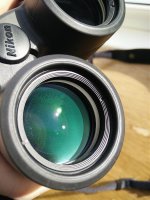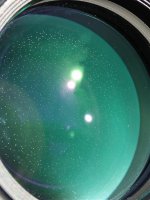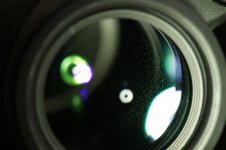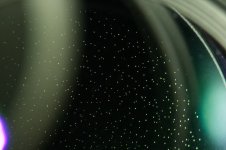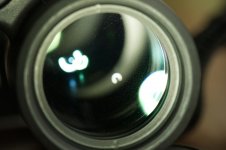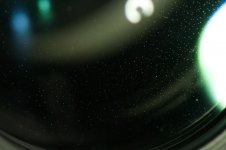I have a pair of Nikon HG 8x32 (originals) that I have since replaced with Swaro's but got them out of their box again to keep near the back window to watch garden birds on our feeders.
I noticed some speckles on the inside of the objective lens or maybe even further in as it is difficult to see the lens construction.
It doesn't look like dust, may be some sort of fungus?
Anyone had the same problem?
Whatever it is, can it be prevented as I don't want the same happening to my swaros, they already have a 1 single dot inside the objectives.
There are ~3.5 million types of fungi. But, of the 2.25 million I am familiar with ... (yeah, right!) this does not appear to be one. Examples are too uniform in size and spacing. I would be pleased to know what you find.
Several years ago, just at the time when working with Nikon west bino repair was transitioning for heaven to hell, I received a shipment of inexpensive binos that, when viewing a bright sky appeared to be 3 or 4 times as speckled as your objective. With the specks transparent and so well in focus, I knew the location and cause.
Tightening down the tiny retainer on the field lens-in which there was too much lubricant-caused that lubricant to spray out in microscopic droplets which landed on the front surface of that lens.
This was at a time when I was no longer allowed to speak to a tech but had to speak only with the "manager" (who shall remain nameless). I was asked to send the lot back. I did.
Those instruments were returned to me without ANY of those droplets. Instead, each lens was coated in dozens of swirl marks indicating that the AR coatings were not meant to be touched and were unreasonably fragile. Representing the merchant, Captain's, I complained again. It was either that or knowingly sell my customers inferior products. All I wanted was the level of performance from Nikon west with which I had long been familiar.
Years earlier, I had thrown my hat into the ring for doing Nikon's west coast binocular repair work. This gave the frustrated manager an "out." He insulted me severely and said I was just trying to "leverage" my way into getting Nikon's bino repair work. But, of course, it is much easier to artificially place blame than it is to own up to mistakes that could get you in trouble with your boss. This could be the reason why Yelp gave the customer satisfaction rating of 2.5 out of 5 stars. I had hints that fellow was running a separate repair business under the Nikon "umbrella" and that he is no longer with the company. Amen! :cat:
Bill




